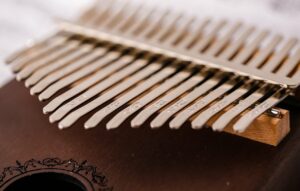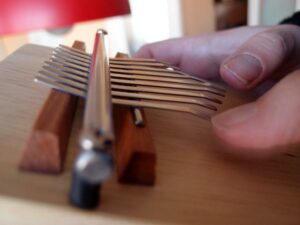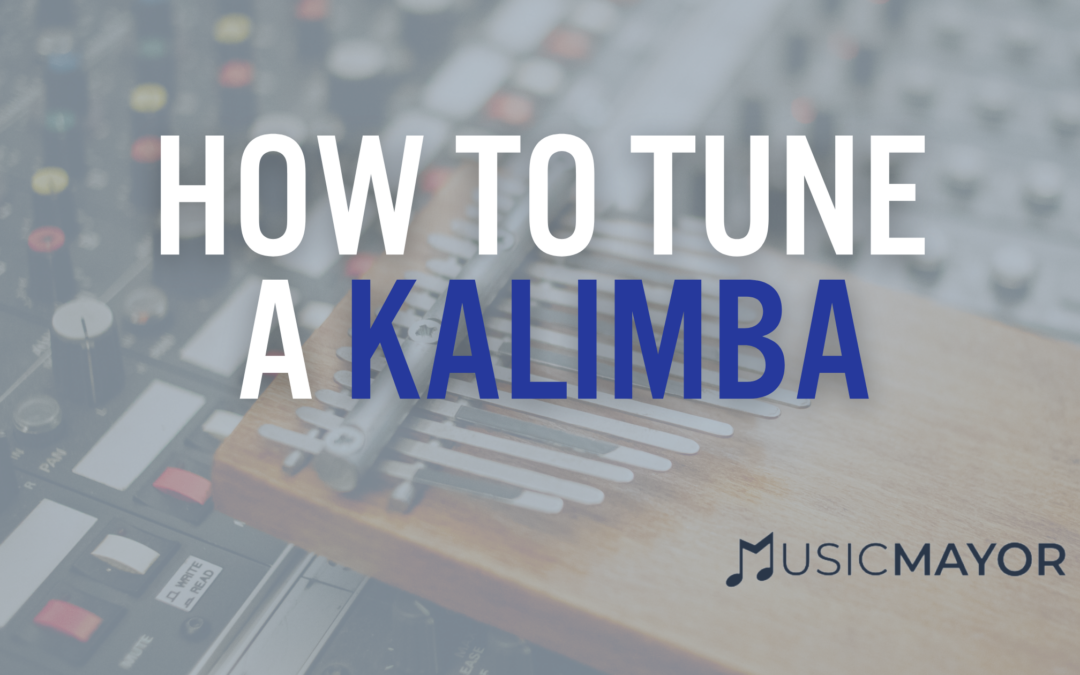Kalimbas are beautiful instruments with a haunting sound. They’re easy to learn and are not too loud, so your neighbors won’t hate you.
This instrument has grown in popularity over the last few years, but they’re still relatively unconventional. It can be difficult to find good advice about looking after your kalimba and keeping it in tune.
Don’t worry because we’re here to help.
Keeping your kalimba thumb piano in tune will ensure that you make lovely music. If any of the tines move out of place, it will affect the sound your instrument produces. Let’s look at the best ways to do this so that you can play your kalimba without any problems.
What You Will Need
Kalimba

Also called the African thumb piano, the kalimba originated in Zimbabwe. It is comprised of a wooden board with staggered metal tines and creates a rich, percussive sound.
A kalimba can have between 5 and 17 keys. However, the method for tuning the instrument remains the same. You must adjust the length of each tine to produce a clearly defined note.
Tuner
The easiest way to check the tuning of each key is to use a tuning tool.
Electronic tuners are popular and widely available. Brands like Korg have a good reputation and give accurate readings. They’re relatively cheap and if you look after them, they’ll last for a lifetime and can be used with any instrument.
Another option is to download a chromatic tuner app. One of the most popular tuning apps is gStrings and is available on the PlayStore.
KLIQ UberTuner - Professional Clip-On Tuner for All Instruments (multi-key modes) - with Guitar, Ukulele, Violin, Bass & Chromatic Tuning Modes (also for Mandolin and Banjo)
13 used from $11.99
There are many others available for both Android and iOS, like DaTuner and Pano Tuner. The quality can vary between apps and the musical instrument so you may need to test a few out before you settle on using one.
Tuning Hammer
If you buy your kalimba from a reputable dealer, it will come with a carry case and a tuning hammer. Kalimba hammers are also widely available online at a low cost.
The hammer is important for adjusting the kalimba keys with small taps. These affect the distances between the tine and bridge.
Kalimba Tuning Hammer, Thumb Piano Metal Tuning Hammer, Instrument Tool Accessory
$6.81 in stock
Features
- ♫ [PREMIUM MATERIAL]- Made of 100% stainless steel, strong and reliable;
- ♫ [EASY OPERATION]- Tune your kalimba easily;
- ♫ [FINE WORKMANSHIP]- Exquisite workmanship with nice texture; specially designed handle for comfortable grip;
- ♫ [PORTABLE]- Lightweight; easy to carry around;
- ♫ [GOOD CHOICE]- Perfect to go with Kalimba gift.
A light tap with the hammer will help to adjust the pitch of each key. Be gentle because it would be terrible if you damaged your kalimba.
Why is My Kalimba Out of Tune?
A Kalimba should stay in tune for a few weeks. As time progresses, you will hear gradual changes. The more often and intensely you play, the quicker these changes will occur.
That’s why it’s important to be able to tune your instrument so that you can continue to enjoy it. Dropping your kalimba or snagging it on clothing may also affect the tines. Don’t worry as it’s easy to fix.
How to Tune A Kalimba
Your kalimba will arrive tuned to a specific key. C Major is standard so let’s look at it first.
Use your tuner or tuning app to find the note. The needle should point to the note in the center of the screen. If it points left, then the note is too flat. On the other hand, if it points to the right, it is too sharp.
The kalimba key C Major is relatively easy to use because of the lack of flats or sharps. The C Major scale is C-D-E-F-G-A-B.

- Play the first note you want to tune a couple of times before adjusting it. The tuner needs to register it correctly. This is especially important if you’re using a phone app.
- Begin outside the kalimba before moving in. (the shorter tine) You can either push or pull the tine to make an adjustment or use the tuning hammer. Gently tap it so that it moves toward the note. If the note is too flat, you should tap the tine upwards and away from the soundhole. However, if it’s too sharp, then you should do the opposite.You can use your tuning app or electronic tuner to ensure that you’re adjusting the correct notes.
- If your tuner reads a note that isn’t in the key, you’ll either have to tune it up or down. For example, if it reads E Sharp, you will need to tune it to either E or F.
Changing to Another Key
If you get bored with whatever key you’re using, you can choose any tuning you prefer. But try to remember the original tuning so that you can go back to basics if you mess up.
Simply adjust the length of each tine to change individual keys or a different scale. This instrument offers many possibilities and is fun to explore.
Your kalimba may also have different roots and base notes. This can also be interesting to play with.
Buzzing Tines
Sometimes individual tines may buzz after you’ve finished tuning them. This is not unusual, and it’s relatively easy to fix. Usually, it happens because they aren’t evenly spaced.
Just move the tine into a position where it doesn’t make any interfering sounds. However, some kalimbas have hexagonal sockets. In this case, you’ll need a hex key to loosen or tighten the tine.
You may also need to adjust the tines on either side of the buzzing perpetrator, but it’s unlikely you’ll have to do the entire kalimba.
☕ Easy Guide How To Tune Your Kalimba | Kalimba Guide ✨
The most basic and an easy way to tune your...
Patience
Keep in mind that tuning can be a tedious process if you’re not used to it. Don’t lose patience because it will take longer, and you could damage your instrument.
Be careful using your tuning hammer because you don’t want to accidentally hit the kalimba.
Remember that it’s normal to take at least thirty minutes to tune your kalimba in the beginning. As your instrument becomes more familiar, it will get much smoother and should only take a few minutes.
Final Thoughts
Keeping your kalimba in tune is just as important as any other instrument.
All you need is a tuning app, a hammer, and patience. Over time it will become second nature, and you may even be able to adjust your kalimba by ear. It doesn’t matter if you’re a beginner or an advanced player; you won’t be able to appreciate your instrument if you don’t maintain it properly.



